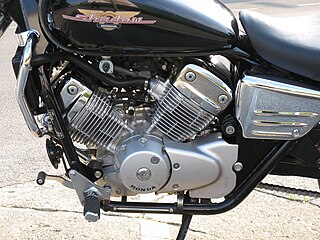
A V-twin engine, also called a V2 engine, is a two-cylinder piston engine where the cylinders are arranged in a V configuration and share a common crankshaft.

Moto Guzzi is an Italian motorcycle manufacturer and the oldest European manufacturer in continuous motorcycle production.
Nikasil is a trademarked electrodeposited lipophilic nickel matrix silicon carbide coating for engine components, mainly piston engine cylinder liners.

The Honda CX series motorcycles, including the GL500 and GL650 Silver Wing variants, were developed and released by Honda in the late 1970s, with production ending in most markets by the mid 1980s. The design included innovative features and technologies that were uncommon or unused at the time such as liquid cooling, electric-only starting, low-maintenance shaft drive, modular wheels, and dual CV-type carburetors that were tuned for reduced emissions. The electronic ignition system was separate from the rest of the electrical system, but the motorcycle could only be started via the start button.
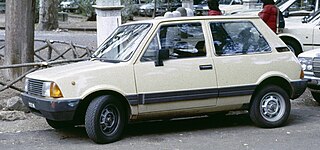
The Innocenti Mini is an automobile introduced by Innocenti in 1974. The vehicle was a rebodied, three-door hatchback version of the Mini, styled by Bertone. A five-door prototype was developed around 1980, but was never put into production. After having been sold to De Tomaso in 1976, the Innocenti Mini ended up being powered by Daihatsu-sourced three-cylinder engines and continued in production in incrementally updated forms until 1993.

Laverda was an Italian manufacturer of high performance motorcycles. The motorcycles in their day gained a reputation for being robust and innovative.
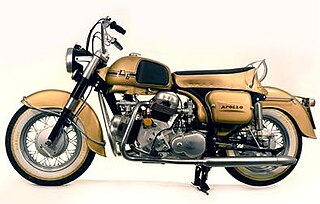
The 1964 Ducati Berliner 1260 Apollo was a prototype 1,257 cc (76.7 cu in) V4 engine motorcycle producing 100 bhp (75 kW) and capable of over 120 mph (190 km/h). It was never put into production, but did influence other production Ducatis that followed. Both Ducati and their United States distributor, Berliner Motor Corporation, were experiencing declining sales of existing small-capacity single-cylinder models, and sought to create a bike to compete with Harley-Davidson. Berliner Motor was keen to have a model that could win lucrative police motorcycle supply contracts, and that could also sell as a civilian touring bike.

The Moto Guzzi V8, or the Otto motorcycle was designed by Giulio Cesare Carcano specifically for the Moto Guzzi Grand Prix racing team for the 1955 to 1957 seasons. Though following the two-stroke Galbusera V8 of 1938, the Moto Guzzi Otto motorcycle and its engine represent a unique and historically significant engineering milestone.

Ghezzi & Brian is an Italian motorcycle engineering firm and manufacturer based in Missaglia.
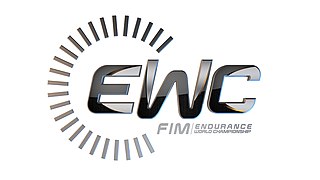
The Endurance World Championship is the premier worldwide endurance championship in motorcycle road racing. The championship season consists of a series of endurance races held on permanent racing facilities. The results of each race are combined to determine three World Championships – riders, teams and manufacturers.

The Moto Guzzi Le Mans is a sports motorcycle first manufactured in 1976 by Italian company Moto Guzzi. It was named after the 24-hour motorcycle endurance race at Le Mans in France. The Le Mans designation was first used for an 850 prototype, based on the V7, displayed at Premio Varrone in late 1972.

Berliner Motor Corporation was the US distributor from the 1950s through the 1980s for several European motorcycle marques, including Ducati, J-Be, Matchless, Moto Guzzi, Norton, Sachs and Zündapp, as well as selling Metzeler tires. Berliner Motor was highly influential as the voice of the huge American market to the motorcycle companies they bought bikes from, and their suggestions, and sometimes forceful demands, guided many decisions in Europe as to which bikes to develop, produce, or discontinue.
Joe Berliner [...] a man endowed with great decision-making power in Borgo Panigale
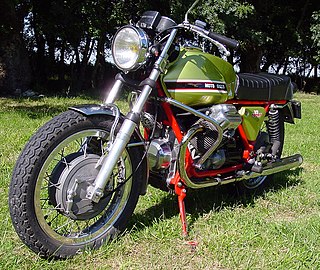
Lino Tonti was an Italian motorcycle engineer known for designing a number of sport and racing motorcycles in the 1950s and 1960s, and for creating his signature 'Tonti frame' for Moto Guzzi's 1971 V7 Sport, setting his stamp on all Moto Guzzis since.

The Moto Guzzi Triporteurs were wheeled transport motorcycles (triporteurs) of the Moto Guzzi brand. In Italy, they are called "motocarri".

Motorcyclewheels are made to cope with radial and axial forces. They also provide a way of mounting other critical components such as the brakes, final drive and suspension. Wheels, and anything directly connected to them, are considered to be unsprung mass. Traditionally motorcycles used wire-spoked wheels with inner tubes and pneumatic tyres. Although cast wheels were first used on a motorcycle in 1927, it would not be until the 1970s that mainstream manufacturers would start to introduce cast wheels on their roadgoing motorcycles. Spoked wheels are usually made using steel spokes with steel or aluminium rims. Cast wheels are predominantly made from an aluminium-alloy, but can also be made from more-exotic materials, such as magnesium content alloy or carbon fibre.
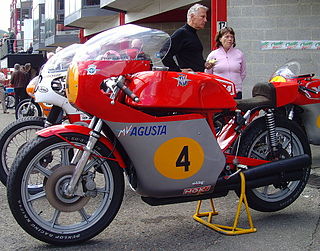
The MV Agusta 500cc road racers were motorcycles that the manufacturer MV Agusta built and which were used to compete in 500cc Grand Prix motorcycle racing series between 1950 and 1976. 18 500cc world championship titles were achieved with these machines ridden by John Surtees, Gary Hocking, Mike Hailwood, Giacomo Agostini and Phil Read between 1958 and 1974.

The MV Agusta 350 6 cilindri was a prototype racing motorcycle built by the Varese company MV Agusta in 1957, for the 350 cc class of the FIM Motorcycle World Championship. The project was resurrected in 1968. Neither version was ever used in a race. The only surviving model is now in the MV Agusta factory museum.
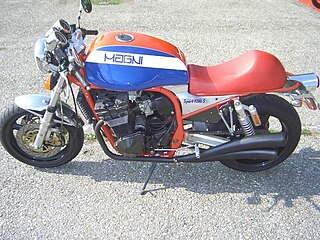
Magni is an Italian company that builds specialist motorcycles. The company is based in the city of Samarate in the province of Varese. Magni, in addition to building the bikes that bear its name, is also active in the construction of specials to order and a supplier of special parts for the restoration of MV Agusta classic motorcycles.

The Ducati Deluxe is a 247 cc (15.1 cu in) single cylinder bevel drive SOHC motorcycle produced by the Spanish manufacturer MotoTrans, who were licensed by Ducati to produce motorcycles under the Ducati brand name. The model was based on the 'narrow case' Ducati Diana 250 and produced from 1963 to 1973. The Deluxe was, in terms of production numbers, MotoTrans' most successful model.

















